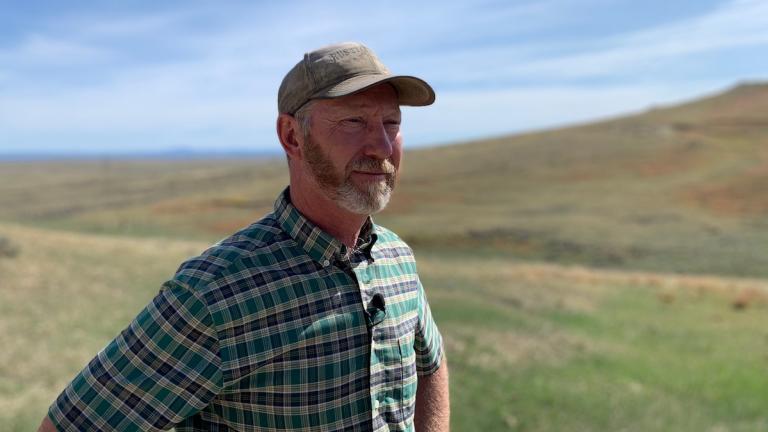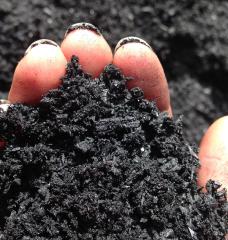
This story by ESI Journalism Fellow Dustin Bleizeffer was originally published for WyoFile, where it appears with additional photos and resources
__________
By Dustin Bleizeffer
We talk a lot about the weather in Wyoming because, like it does in any place occupied by humans, it unites us. Talking about a changing climate in Wyoming, however, can be more difficult.
But when the conversation moves past politics and policy, residents from all walks of life report changes that concern them.
This summer, for example, anglers across the state saw lower streamflows and increasing water temperatures diminish fishing opportunities beginning in July rather than late August. This fall, ranchers faced the difficult decision to reduce herd sizes or pay top-dollar for supplemental hay as they prepared for the winter.
Even some skeptics of human-caused climate change said this summer’s extreme conditions felt like the continuation of dramatic shifts in climate patterns they’ve observed over their lifetimes.
“I can’t say cause and effect,” Campbell County rancher Eric Barlow, who also serves in the state legislature, said. “But I can say that, certainly, [there are] trends that I just don’t quite understand or [they] don’t seem to follow the tradition, you know, from generation to generation.”
WyoFile traveled the state and talked to Wyoming residents about the changes they’re observing on a landscape that they love and depend on, and what those changes might mean to their Wyoming lifestyle.
Changes in agriculture
Few residents are as attuned to the seasonal and cyclical pulse of Wyoming’s climate than those who raise livestock and grow crops. Their livelihoods and identities — going back generations — are intrinsically tied to how the climate’s rhythms play out on a landscape.
And even with Wyoming’s traditional agricultural challenges — harsh weather, limited water, poor soils and volatile weather — there are noticeable changes, many say.
Thayne Gray has been reading through records kept by his father and grandfather on the Warbonnet Ranch outside Moorcroft, he said. Since 1985, the family has instituted an intensive rotational grazing program on its collection of moderately high-and-dry pastures with great success.
Crafted to accommodate the region’s once-typical weather patterns, those practices are, with increasing frequency, not enough to keep up with changing conditions.
In his reading, he said, Gray discovered that the cycles his ancestors recorded don’t reflect those he’s experienced over the past decade or more. Much has changed in his lifetime on the ranch.
“We used to have three to four years of common weather before the cycle would change from a wet cycle to a dry cycle,” Gray said. “Now, you’ll have one of the wettest years — a great wet year — next to the driest the very next year. So, I don’t know what’s causing that, but it’s just something I noticed.”
By September, cattle on the Warbonnet Ranch had already grazed out every summer and winter pasture due to continuing drought conditions made worse by unusually high temperatures. Gray had to pay top-dollar, competing with ranchers across much of the West, for several truckloads of hay to prepare for the winter.
Gray has also noticed what seems to be an emerging snow phenomenon: a warm spell follows a heavy snow. That initiates a thaw, then it freezes tight to the soil, making it almost impossible for cattle to break through the crust for forage.
“I thought it was an anomaly, but it seems to be becoming more consistent with how our winters are coming along,” Gray said.
The Barlow Ranch is bisected by Dead Horse Creek, a tributary to the Powder River, famously described as “a mile wide and an inch deep.” There’s a bit of truth to the aphorism. The river commonly runs dry enough by late August that cattle easily plod across the mucky riverbed without getting stuck.
That opportunity came even earlier this year.
Record breaking triple-digit temperatures baked the landscape in June when, traditionally, moderate rainfall and cool nights curb the heat. Rancher Eric Barlow, a veterinarian and Republican Speaker of the Wyoming House of Representatives, lost seven yak calves that were born in June when temperatures reached 109 degrees Fahrenheit, he said.
“The bum yak calf we have is also a product of that day and the confusion and heat stress the entire herd experienced,” Barlow said.
The cattle, sheep and yak operation relies entirely on artesian springs and drilled wells to water the livestock. On good years, ephemeral creeks are a bonus, Barlow said, providing springtime flows from snowmelt. There are no irrigated pastures, so the operation is entirely dependent on “optimal” precipitation events.
Those optimal events are becoming less common, he said.
“I really do think we’ve seen a change in precipitation patterns,” Barlow said. “Part of the result of that is less reliable forage production year to year, and the timing of the forage.”
Barlow reduced both sheep and cattle numbers this year, he said, and still invested in several truckloads of supplemental feed hay for the upcoming winter.
The changes he’s noticed in his lifetime on the ranch can be summed up as more extremes and less predictability, he said, which makes it difficult to adapt from year to year.
“We do have a hope that, next year, we’ll have whatever normal is,” Barlow said.
Changes to fisheries
When Jeff Streeter began working as a fishing guide on the North Platte River near Saratoga in the 1970s, the river ran full and cold throughout the summer, supporting one of the world’s most sought-after trout fisheries and attracting high-paying anglers.
That hasn’t been the case during the past decade or so, he said.
By mid-July this year, higher-than-average temperatures in the Upper North Platte Valley, combined with years of persistently lower runoff, had already gummed the river with thick moss. The streamflow was so low that fishing guides couldn’t float clients on long stretches of the river, and late-day water temperatures were too warm for trout to survive being caught and released.
“These river systems are stressed when they don’t receive [ample] flows,” Streeter said in July while gearing up for a morning of fishing on the Encampment River, which flows into the North Platte.
Warmer stream temperatures coming earlier in the summer have prompted more frequent “hoot owl restrictions” — regulations designed to improve fish survival by stopping catch-and-release trout fishing in the heat of the afternoon. Anglers must hit the water earlier in the day, if at all, during these conditions.






